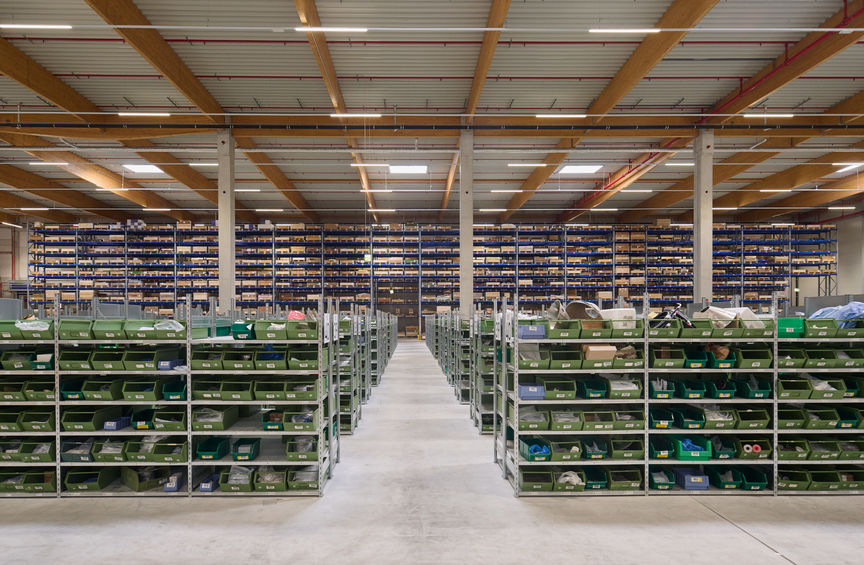Logistics real estate market
In 2024, the market for logistics and production properties saw another year-on-year decline from 230,000 to just over 130,000 square meters, after a record 420,000 square meters were taken up in 2022. This will continue in 2024, with take-up of just over 130,000 square meters. The last time such a low level of take-up was recorded was between 2012 and 2016.
Market sentiment and trends
Over the last ten to fifteen years, there has been a sustained increase in demand for logistics and production space in the region. Most recently, annual demand stabilized at around 400,000 sqm between 2019 and 2022. This solid and high demand has created a market-driven supply of as-new existing properties in recent years.
The current project developments confirm the fundamental confidence in the region as a dynamic location for logistics and production.
There are various demand and supply-related reasons for the significant decline in take-up in 2023 and 2024. At present, however, the persistent economic slowdown in the manufacturing sector and the associated uncertainties for the logistics industry are likely to be the main reason for the comparatively weak take-up.
Another 270,000 square meters of hall space by 2026
In the years from 2019 to 2024, around 970,000 sqm of hall space for logistics and production was completed in the Hannover Region. The projects planned or already known for the years 2025 to 2026 add up to around 270,000 sqm of hall space, which corresponds to a comparatively high increase in hall space.
The increased proportion of speculative project developments in recent years should be emphasized, which ensures that modern space can also be rented at short notice. However, the current project pipeline is subject to increased uncertainty in view of the polycrisis environment, and some projects have already been delayed.
Prime rent remains constant
The prime rent of EUR 6 .40 per sqm corresponds to the previous year's figure. Depending on the level of furnishings and location, however, individual properties can also achieve significantly higher rents.
Logistics and production strongest asset class on regional investment market
At almost 50%, most investments were made in the logistics and production real estate submarket in 2024, although this figure was almost three quarters in the previous year. A good EUR 200 million was transacted in 2024; the market is primarily characterized by the sale of large properties as part of portfolio transactions in the logistics sector.
The peak yield in 2024 was up to 4.8%, 0.3 percentage points higher than in 2023.
Outlook: restraint in the short term - high demand pressure in the long term
The challenges facing the logistics sector and industry have changed over the last three years. Two trends in particular will lead to an increased need for suitable storage space in the long term, but are currently on the decline:
- Online retail, which has built up very large space capacities in recent years, is not currently the strong demand driver. In the future, however, demand pressure from e-commerce will remain the main driver of demand for space in the logistics real estate market.
- The effect of the re-shoring and near-shoring of production facilities to Germany and neighboring European countries has so far been minimal. However, the energy transition, digitalization and the increasing importance of electromobility in the automotive industry are promoting restructuring that is fundamentally benefiting the market for logistics and production properties.
In the medium to long term, market participants therefore expect demand for warehouse space to pick up again and the high capacity utilization of logistics infrastructures in the courier, express and parcel services sector to continue or grow further.
At present, however, the weak economy throughout Germany is having a negative impact on the fundamentally robust logistics industry and thus on the specific demand for real estate for logistics and light manufacturing.
The Hannover Region remains a strong and resilient location for logistics
From the perspective of market participants, the Hannover Region has been positioned as a strong and stable location for logistics and industry for many years. Politics and administration have responded in recent years with a more sustainable land policy: In addition to more economical and targeted land rezoning , municipal players are focusing more on the revitalization of brownfield sites.
Against this backdrop, developers are increasingly focusing on brownfield developments . Municipalities are increasingly focusing on a strategic commercial space policy to secure commercial space in a targeted manner and facilitate integrated solutions instead of prioritizing the designation of new commercial space on greenfield sites.
In the coming years, the demands to act sustainably are likely to become even more insistent. Municipalities and companies will focus more on revitalizing existing properties and pre-used commercial locations. It is already becoming apparent today that it will not otherwise be possible to meet the prospect of a renewed increase in demand for logistics space, particularly in regions with high demand such as Hanover.

